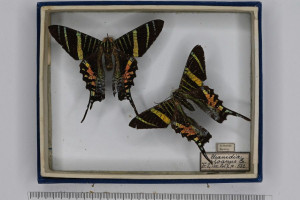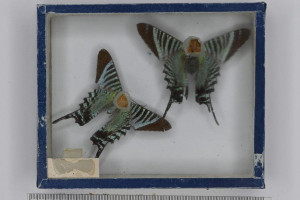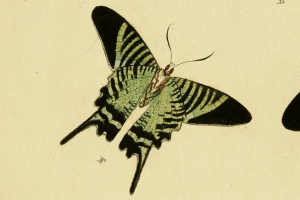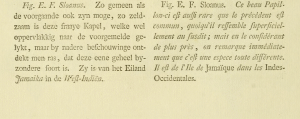2. Diagnose
2.1. Falter
2.2. Erstbeschreibung, darin indizierte Abbildungen zu Text zu diesen
3. Weitere Informationen
3.1. Andere Kombinationen
- Papilio sloanus Cramer, [1776] [Originalkombination]
3.2. Vorkommen
Die ausgestorbene Art gilt als Endemit von Jamaika. Vinciguerra (2009: 309) untersuchte zwei Exemplare, die mit dem Jahr 1908 etikettiert sind. Er räumt die Möglichkeit ein, dass 1908 das Jahr der Aufnahme in die Sammlungen ist und nicht das Jahr, in dem die Falter gefangen wurden.
Domagała & Dobosz (2019) fanden vier Exemplare in schlesischen Sammlungen, davon zwei ohne Angabe der Herkunft, eines mit einem Etikett „Venezuela“ und eines mit dem Etikett „Brasilien“. Domagała et al. (2015: 456-457) bemerken zu Venezuela: “Even though the label attached to the specimen indicates that it comes from Venezuela, South America, this seems to be a negligible possibility (G. Lamas and A. Viloria, personal communication). The typical host of U. sloanus was O. triandra (Euphorbiaceae) also endemic to Jamaica, although all Urania species are oligophagous. Thus it is possible that they could feed on other Omphalea species such as O. diandra, also present in Jamaica but distributed in Central America and northern South America, including Venezuela (Lees & Smith, 1991; Funk et al., 2007). Two species of Urania (U. fulgens and U. leilus) are known from Venezuela and they have been reported flying long distances and even involved in migrations (Beebe, 1951; Manara, 1994; Osuna, 2000; Raymond, 1982; Sandoval et al., 2007; Schmid & Endicott, 1967). And even though U. sloanus was once reported from Cuba (Sagra, 1857), such a possibility was discarded by other researchers. Furthermore, the Uraniidae have been recognized as great flyers and involved in long distance migrations, and with the help of strong Caribbean winds some individuals may have reached the coast of northern South America. Thus, hypothetically, it may be possible that a vagrant specimen arrived in Venezuela to be later collected. However, the species has never been reported before from continental South America, as its possible alternative host plant (O. diandra).”
Das Kurzzitat „(Sagra, 1857)“ in Domagała et al. (2015: 456) betrifft Guérin-Méneville (1857: 654), der zu U. sloanus lapidar bemerkt: « Cydimon sloanus, Cram. [...] Elle habite l'ile de Cuba; elle se trouve aussi à la Jamaïque. ».
(Autor: Jürgen Rodeland)
3.3. Publikationsjahr der Erstbeschreibung
Nur der „Naamwyzer van de dag- en nagt-kapellen“ – im Band 1 der "uitlandsche kapellen" die Seiten 151-155 – ist maßgeblich für das Erscheinungsjahr der Erstbeschreibung, weil dies der einzige binominale Teil des Bandes ist. Nach Hemming (1958: 41) wurden diese Seiten 1776 publiziert.
(Autor: Jürgen Rodeland)
3.4. Literatur
- Erstbeschreibung: Cramer, P. („1779“) [1775-1776]: De uitlandsche kapellen voorkomende in de drie waereld-deelen Asia, Africa en America 1: I-XXX, 1-155, pl. I-CXVI. Amsteldam (S. J. Baalde), Utrecht (Barthelemy Wild).
- Domagała, P. J. & R. Dobosz (2019): Urania sloanus (Cramer, 1779) (Lepidoptera: Uraniidae), an enigmatic extinct species in Polish museum collections. — Annales zoologici 69 (4): 697-702. Warszawa. [Zum PDF auf researchgate.net]
- Domagała, P., Larysz, A., Dobosz, R. & J. M. González (2015): Urania sloanus (Cramer, 1779), an extinct species in the collection of the Upper Silesian Museum (Muzeum Górnośląskie), Bytom, Poland (Lepidoptera: Uraniidae). — SHILAP Revista de lepidopterología 43 (171): 455-460. [PDF auf redalyc.org]
- Guérin-Méneville, F. E. (1857): Histoire physique, politique et naturelle de l'ile de Cuba. Partie descriptive. Insectes. — In: de la Sagra, R. (1857): Histoire physique, politique et naturelle de l'ile de Cuba 9: 1-829, pl. 6-20. — Digitalisat auf biodiversitylibrary.org: [654], [pl. 17 (keine Abbildung von U. sloanus, nur von U. boisduvalii)]
- Hemming, F. (1958): Opinion 516. — Opinions and Declarations Rendered by the International Commission on Zoological Nomenclature 19 (1): 1-44. London.
- Nazari, V., Schmidt, B. C., Prosser, S. & P. D. N. Hebert (2016): Century-Old DNA Barcodes Reveal Phylogenetic Placement of the Extinct Jamaican Sunset Moth, Urania sloanus Cramer (Lepidoptera: Uraniidae). — PLoS ONE 11 (10): 1-13. [PDF auf journals.plos.org]
- Vinciguerra, R. (2009): Osservazioni su Urania sloanus (Cramer, 1779) (Lepidoptera: Uraniidae). — SHILAP Revista de lepidopterología 37 (147): 307-312. [PDF auf redalyc.org]




![Ausgestorben oder verschollen in Jamaika [Locus typicus]](/res/img/flag/jm.gif)








